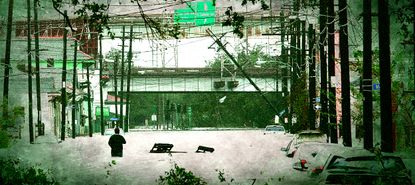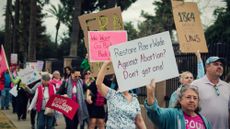How New Orleans' flooding risks are exacerbated by climate change
The region faces multiple overlapping threats that require long-term solutions


We need long-term solutions to Louisiana's flood problems.
As of this writing, Hurricane Barry was expected to make landfall as a category 1 hurricane Saturday, and it appears that New Orleans and the surrounding areas have avoided a worst-case scenario. After an extraordinarily rainy spring season, there was concern Barry's storm surge would push an already swollen Mississippi River over the city's levees. That risk has subsided for now, but the area still faces dangerous and damaging flooding, with as much as 30 inches of rainfall expected to test already-stretched systems across the state over the next few days.
The whole situation is a vivid illustration of the multiple overlapping threats the city and region face, all of which are exacerbated by climate change.
Subscribe to The Week
Escape your echo chamber. Get the facts behind the news, plus analysis from multiple perspectives.

Sign up for The Week's Free Newsletters
From our morning news briefing to a weekly Good News Newsletter, get the best of The Week delivered directly to your inbox.
From our morning news briefing to a weekly Good News Newsletter, get the best of The Week delivered directly to your inbox.
New Orleans can flood in a few different ways. The first is rainfall. Earlier this week, New Orleans flooded when nearly nine inches of rain fell on the city in just three hours. The streets filled with water, cars were submerged, and first stories flooded. A little over 50 percent of the city is below sea level, so when it rains the bowl begins to fill. The city has over 100 pumps that work to keep the streets dry. But when that much rain falls that fast, the pumps can't keep up and the streets flood. City officials like to remind us that no system in the world could keep up with this amount of rainfall. What do we have to do to make one that will?
The second way New Orleans can flood is from Lake Borgne and Lake Pontchartrain, which border the city to the east and north, as happened during Hurricane Katrina when a storm surge was pushed from the Gulf into the lakes. The water from Lake Borgne funneled between the Gulf Intracoastal Waterway and Mississippi River Gulf Outlet, pressuring the Industrial Canal floodwalls until they broke. From Lake Pontchartrain, water was pushed into multiple canals which also caved under the pressure. Elsewhere, water flowed freely over levees that were shorter than the height of the storm surge. When a levee actually breaks (rather than just overtopping), the water that it was holding back is released. In Katrina's case, this meant that water flowed into the city until the water height in the city matched that of the Lake, leaving 80 percent of the city flooded. Although significant changes have been made to this part of the system since the failures of 2005, reports from earlier this year suggested a similar scenario is still well within the realm of possibility, especially with rising sea levels and the likelihood of more frequent and more severe storms.
The third way the city can flood is from the Mississippi River, which curves around the western, southern, and eastern side of the city. When New Orleans was first settled, it flooded regularly from the river but, over time, levees were built to hold it in place. The height of the river levees vary slightly from place to place with the lowest points about 20 feet above sea level (there has been some recent confusion regarding the exact heights).
Usually around this time of year the river can comfortably accommodate a storm surge from a hurricane without a serious threat to the city. During Hurricane Isaac, the river was three feet above sea level, so when it raised another 6.5 feet during the storm there was no concern of overtopping. Even during Katrina, the river stayed below 16 feet. But this week, as Barry formed in the Gulf, the city was looking at a particularly dangerous scenario. On Friday evening, right before the storm, the height of the river was measured at a shocking 16.9 feet and projections suggested the river could rise to 19 feet, a height not seen in at least 69 years. Earlier in the week the projection was 20 feet, close to overtopping in several places. Water from the river could have flowed into neighborhoods — something that has not happened in modern times. While any flooding in New Orleans can cause problems, an overtopped river levee wouldn't be anything close to a Katrina-level catastrophe — one in Plaquemines Parish, south of the city, was reported to have overtopped Saturday morning, but a parish spokesperson told The New York Times the community was prepared for the situation. An unintentional river levee failure, on the other hand, would be devastating for the city, but thankfully shouldn't be a significant risk in this storm.
Keeping New Orleans dry is a numbers game. The flood control system in and around the city is one of the most complex systems of its kind in the world. There are canals to channel the water, pumps to remove the water, flood gates and walls to hold water back, greenspace to absorb water, levees to keep water out of the city and levees to keep water in the river. It's all connected and the failure of just one component, let alone multiple, is something New Orleanians understand all too well.
Outside of the city, the Louisiana coast faces down storm surge and is now dealing with the impacts of the triple threat of erosion, subsidence, and sea level rise. Some communities like Isle de Jean Charles, where several people were had to be rescued Saturday, are seeing the land literally disappear below them. Even inland Baton Rouge was recently devastated by flooding.
In this way, Louisiana exemplifies our continued reality in the climate crisis: our communities will face overlapping hazards. This week, record spring flooding has collided with hurricane season and the outcome could be devastating. Elsewhere in the country as fire season begins, higher temperatures combine with changing weather patterns to increase our risk. So, in addition to doing what we can to mitigate those climate change risks, we need a nationwide investment to ready ourselves to manage disasters when they do happen.
New Orleans needs pumps that can keep the city dry during heavy rainfall. Officials need to manage the river to keep it low enough to accommodate storm surges during hurricane season. And, they need a levee system that is built correctly and will grow with the changing climate threats. Coastal Louisiana needs the Coastal Master Plan implemented and places like Baton Rouge need to continue flood mitigation efforts.
The emergency management system is supposed to prepare us to respond and recover to the disasters we don't prevent. But one disaster after another across the country is putting the system under strain. The Federal Emergency Management Agency is facing questions about their capacity to respond to continuously unfolding disasters and there are concerns about nonprofits having the resources to address needs which are left unmet.
An American city living on the brink of destruction from a relatively minor storm isn't a sustainable future. Nor is standing by quietly as the coast disappears below the waves. This is the reality we've made. Now we have to figure out a way to live in it.
Create an account with the same email registered to your subscription to unlock access.
Sign up for Today's Best Articles in your inbox
A free daily email with the biggest news stories of the day – and the best features from TheWeek.com
Samantha Montano is an assistant professor of emergency management and disaster science at University of Nebraska Omaha. She has a doctoral degree in emergency management and writes at Disaster-ology.
-
 Cicada-geddon: the fungus that controls insects like 'zombies'
Cicada-geddon: the fungus that controls insects like 'zombies'Under The Radar Expert says bugs will develop 'hypersexualisation' despite their genitals falling off
By Chas Newkey-Burden, The Week UK Published
-
 'Voters know Biden and Trump all too well'
'Voters know Biden and Trump all too well'Instant Opinion Opinion, comment and editorials of the day
By Harold Maass, The Week US Published
-
 Is the Gaza war tearing US university campuses apart?
Is the Gaza war tearing US university campuses apart?Today's Big Question Protests at Columbia University, other institutions, pit free speech against student safety
By Joel Mathis, The Week US Published
-
 Arizona court reinstates 1864 abortion ban
Arizona court reinstates 1864 abortion banSpeed Read The law makes all abortions illegal in the state except to save the mother's life
By Rafi Schwartz, The Week US Published
-
 Trump, billions richer, is selling Bibles
Trump, billions richer, is selling BiblesSpeed Read The former president is hawking a $60 "God Bless the USA Bible"
By Peter Weber, The Week US Published
-
 The debate about Biden's age and mental fitness
The debate about Biden's age and mental fitnessIn Depth Some critics argue Biden is too old to run again. Does the argument have merit?
By Grayson Quay Published
-
 How would a second Trump presidency affect Britain?
How would a second Trump presidency affect Britain?Today's Big Question Re-election of Republican frontrunner could threaten UK security, warns former head of secret service
By Harriet Marsden, The Week UK Published
-
 'Rwanda plan is less a deterrent and more a bluff'
'Rwanda plan is less a deterrent and more a bluff'Instant Opinion Opinion, comment and editorials of the day
By The Week UK Published
-
 Henry Kissinger dies aged 100: a complicated legacy?
Henry Kissinger dies aged 100: a complicated legacy?Talking Point Top US diplomat and Nobel Peace Prize winner remembered as both foreign policy genius and war criminal
By Harriet Marsden, The Week UK Last updated
-
 Trump’s rhetoric: a shift to 'straight-up Nazi talk'
Trump’s rhetoric: a shift to 'straight-up Nazi talk'Why everyone's talking about Would-be president's sinister language is backed by an incendiary policy agenda, say commentators
By The Week UK Published
-
 More covfefe: is the world ready for a second Donald Trump presidency?
More covfefe: is the world ready for a second Donald Trump presidency?Today's Big Question Republican's re-election would be a 'nightmare' scenario for Europe, Ukraine and the West
By Sorcha Bradley, The Week UK Published